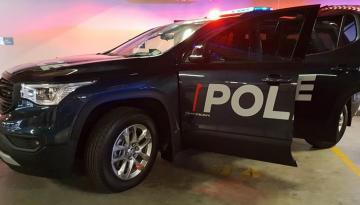A trial of the country's first armed police officers saw them used most often for traffic stops instead of armed offenders or serious crime.
The six-month trial of Armed Response Teams (ARTs) was launched by police last October, with former Police Commissioner Mike Bush saying they'd be focussed on crimes that caused "significant risk".
But data obtained by Newshub Nation shows they largely did the work of normal police.
"One of the concerns, when these teams were introduced, was they would be an introduction of armed units into routine policing by stealth, and looking at the data that's emerged those fears seem to be realised," says former police officer Tim McKinnel.
The data shows armed police were used 339 times for bail checks, 224 times for basic enquiries, 223 times for suspicious activity and 43 times for burglar alarms.
Most of all, on 1406 occasions, armed police were used for turnovers - the force's code for a simple traffic stop.
"Vehicle turnovers are the most routine form of proactive policing there is and there's very rarely a need for armed police to be doing that," McKinnel says.
ARTs were designed to respond more quickly to shooters in the wake of last year's Christchurch attack.
"The operating environment has changed, particularly since March 15," Cmmr Bush said at the time.
The full-time armed officers were equipped with Bushmaster rifles and carried Glock pistols on their hips.
Trialed in Auckland, Waikato and Canterbury, they were meant to focus on guns and high-risk crime. But from October last year to January, firearms offences made up less than 3 percent of incidents attended by armed police.
Of nearly 500 people apprehended, more than half didn't have a weapon, and just 14 percent carried a gun.
"The fact we have armed police getting involved in general policing I think is a concern - and will be a concern for many communities, including Māori and Pasifika communities, who had real fears about how these teams were going to be deployed," says McKinnel.
The data also shows the trial had a disproportionate impact on Māori. Nearly half of those apprehended were Māori, with Pasifika making up another 11 percent.
Former cop and justice advocate Sir Kim Workman says that result is no surprise.
"I think it's history repeating itself, because in the last 10 years 66 percent of those shot by police were either Māori or Pacific."
Sir Kim has laid a complaint with the Waitangi Tribunal, alleging Māori were never consulted and would feel the effects most of all.
"I realised that we had to do something, because somebody will be killed before long, and it could end up with innocent bystanders or children," he says.
Other documents obtained by Newshub Nation show the trial had early problems.
An evaluation of its first month in action found officers weren't filling in required forms, and "completion of survey tools has been exceedingly poor".
The surveys to measure perceptions of safety had "not been engaged with" and this meant nothing could be learned. "Based upon the data at hand, no valuable insights [could] be attained," the document reads.
CmmrAndrew Coster wasn't available for interview for this story, and neither was anyone else from New Zealand Police.
But in a statement, a spokesperson acknowledged armed police attended "lower priority incidents where available and appropriate to do so". They didn't answer questions as to why.
Critics of arming officers say there are questions to answer before any permanent changes are made.
The six-month trial finished in April and is currently being evaluated by police. It will need to answer a fundamental question: do cops with guns belong on New Zealand streets?



